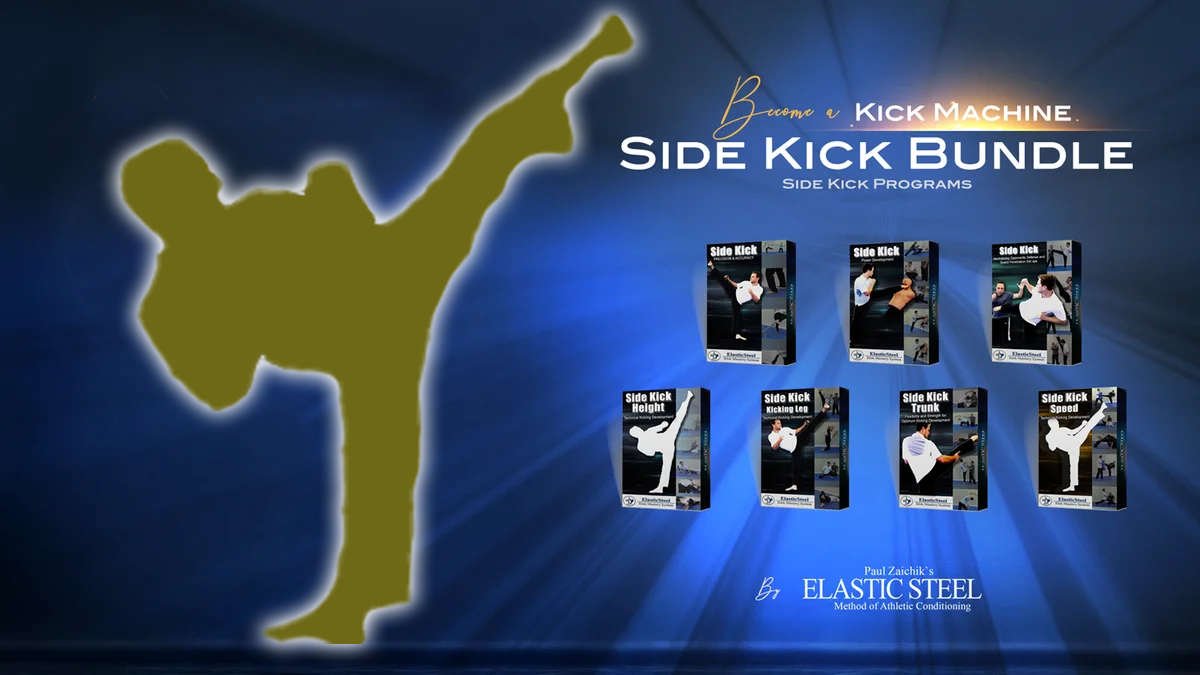
SIDE KICK ULTIMATE COLLECTION
Whether on the streets or in the competitive arena, a side kick can decisively halt an adversary in their tracks. Yet, its full potential remains largely untapped. The key to unleashing the true power of the side kick lies significantly in its preparation. The strength of a kick (or punch) correlates with the amount of mass shifted.
This necessitates a longer trajectory, making the movement more predictable and, consequently, easier to counter. Only a handful of fighters consistently succeed in landing a side kick without setup, much like the rarity of connecting with every straight right punch thrown. Effective power moves demand strategic preparation.
With our Side Kick Combo, you'll gain the insights and techniques to not only execute this powerful move with precision but also to integrate it seamlessly into your repertoire, making it a formidable tool in your arsenal. Elevate your skills and unlock the full potential of your side kick, along with so much more, to truly dominate in any scenario.
This necessitates a longer trajectory, making the movement more predictable and, consequently, easier to counter. Only a handful of fighters consistently succeed in landing a side kick without setup, much like the rarity of connecting with every straight right punch thrown. Effective power moves demand strategic preparation.
With our Side Kick Combo, you'll gain the insights and techniques to not only execute this powerful move with precision but also to integrate it seamlessly into your repertoire, making it a formidable tool in your arsenal. Elevate your skills and unlock the full potential of your side kick, along with so much more, to truly dominate in any scenario.
These programs were designed by Paul Zaichik, martial arts and kinesiology expert with over 30 years experience, founder of ElasticSteel in 2005.
Paul Zaichik and his team have been perfecting martial arts training since then, and here we bring you all this distilled knowledge to make you and unstoppable kicking machine.
This Ultimate Side Kick Bundle Includes the following:
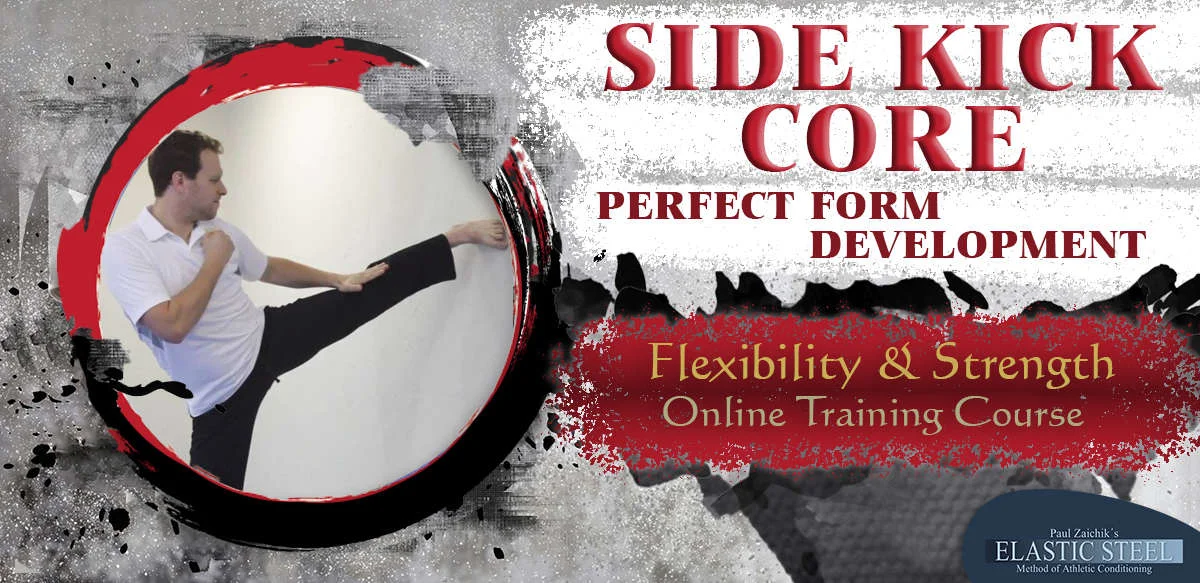
SIDE KICK CORE
PERFECT FORM DEVELOPMENT
PERFECT FORM DEVELOPMENT
Side Kick and Side Line Kicks: Trunk Flexibility and Strength Development for Optimum Kicks Development
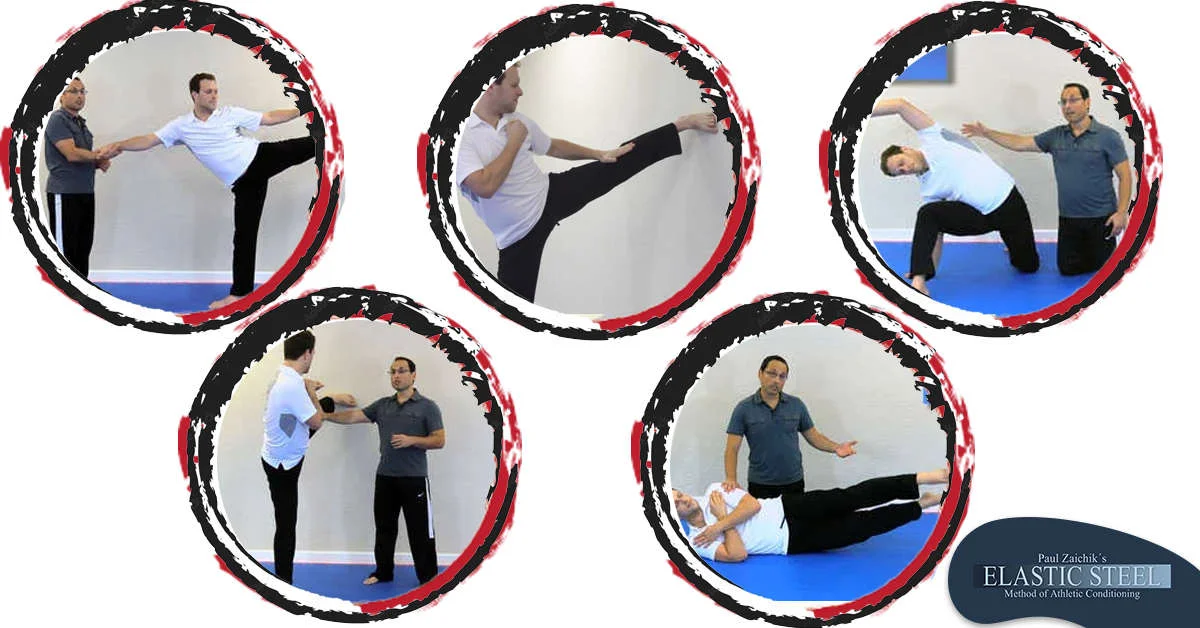
Here's an exercise from this program that you can try right now!
SIDE KICK CORE DEVELOPMENT
What is the difference between a champions and masters Side Kick and beginner Side Kick? (Roundhouse and Hook Kick too for that matter).
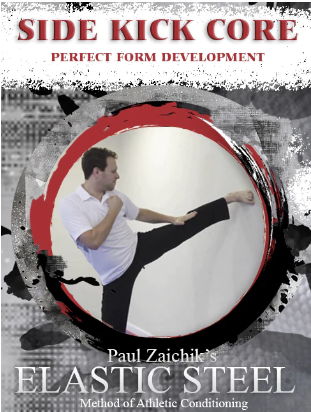
Take a second and visualize the two of them kicking side by side. What do you see? One will have his torso up and one will have it down. Torso position is what makes or breaks the 3 sideline kicks.
If your torso is strong and flexible the kick is hard to see when it’s coming. If the trunk is stiff and weak, it will drop before the kick is initiated. It can be seen a mile away.
Thus is takes less effort to throw a kick when the torso does not have to make a trip to the corner store and back every time the leg comes up. Yes, it’s that important and that’s why we made a program for it.
How can I improve my kick?
If your torso is strong and flexible the kick is hard to see when it’s coming. If the trunk is stiff and weak, it will drop before the kick is initiated. It can be seen a mile away.
Thus is takes less effort to throw a kick when the torso does not have to make a trip to the corner store and back every time the leg comes up. Yes, it’s that important and that’s why we made a program for it.
How can I improve my kick?
Over the years many people would ask me to look at their kicks. Even the high kickers. “What can I do to improve my kick?” they asked. “Torso, your torso position”, was a very common response. Most fighters kick and punch. The better positioned the upper body during the kick, the shorter the pause between a kick and a punch. Or punch and a kick for that matter.
Whether you are a pro fighter or you just train for your enjoyment, you know that the faster you can follow up with your hands after the kick, the more chances you will score.
A very flexible torso is what keeps your punches closer to the target, right after the kick.
Finally, there is the look of the kick, of how the form appears. A kick looks much better when the head is not brushing the floor on the high kick. Think of great competitors with awesome techniques.
Ok, enough said. In this program we focus on the flexibility and strength training of the torso. It’s not a six pack program... (however it will greatly develop the core), but body builder looking abs is not its primary purpose. The purpose is to improve every aspect of the Side Kick, Roundhouse Kick and Hook Kick.
Do you need this program?
Whether you are a pro fighter or you just train for your enjoyment, you know that the faster you can follow up with your hands after the kick, the more chances you will score.
A very flexible torso is what keeps your punches closer to the target, right after the kick.
Finally, there is the look of the kick, of how the form appears. A kick looks much better when the head is not brushing the floor on the high kick. Think of great competitors with awesome techniques.
Ok, enough said. In this program we focus on the flexibility and strength training of the torso. It’s not a six pack program... (however it will greatly develop the core), but body builder looking abs is not its primary purpose. The purpose is to improve every aspect of the Side Kick, Roundhouse Kick and Hook Kick.
Do you need this program?
Let’s see. Stand up and extend a Side Kick waist level. With your finger tips touch the outside part of your leg. Perfect kick dictates finger tips touching half way between your knee and your ankle. If you can do that, you don’t need this program. If you can’t touch that, either your strength is off or your flexibility, which means that you need this program.
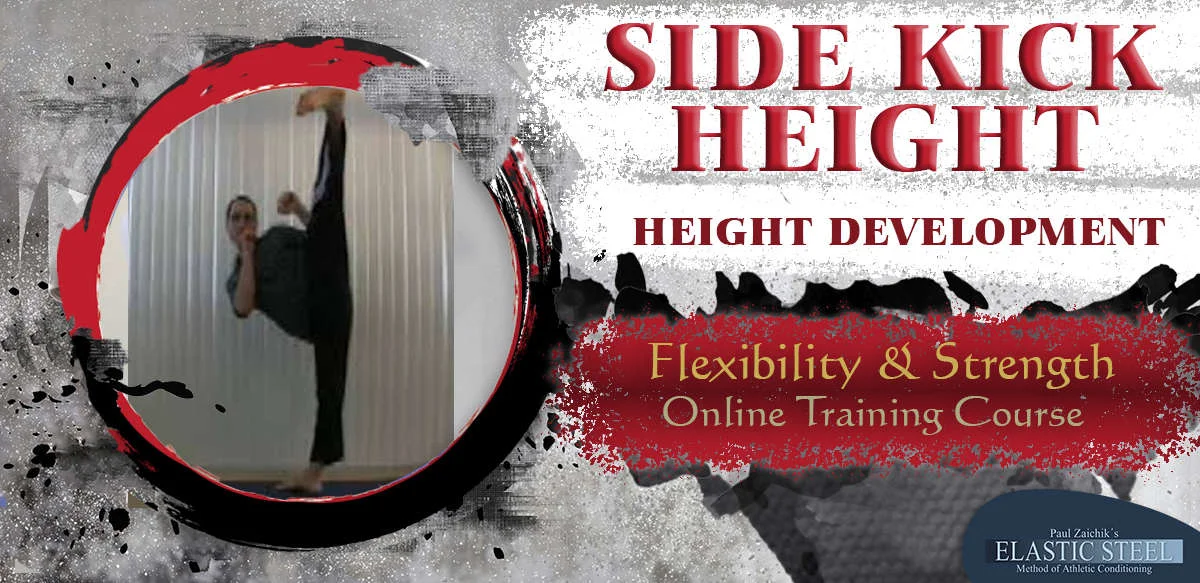
SIDE KICK HEIGHTHEIGHT DEVELOPMENT
Side Kick Height Supporting Leg Online Training Program
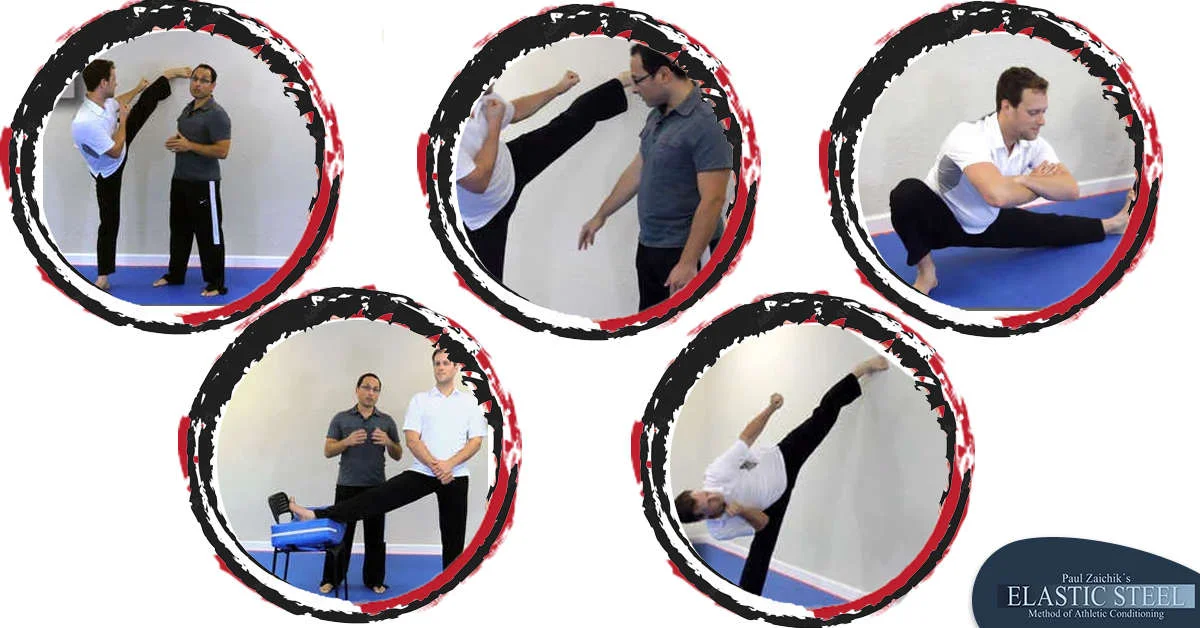
Side Kick Height (for all sideline kicks) Program
This is a program for the kicking height for all 3 side line kicks:
- Side Kick
- Roundhouse Kick
- Hook Kick
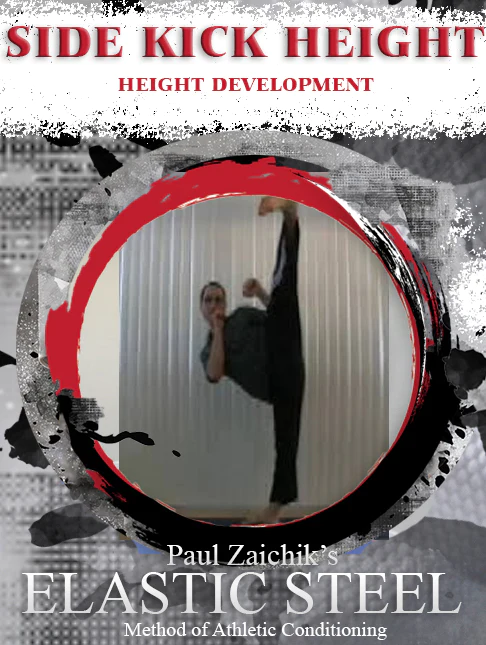
Kicking height of the side line kicks, depends on the flexibility of the supporting leg or standing leg. In order to throw a high kick, the kicking side of the pelvis must tilt up. If the pelvic does not tilt, the kicking hip abduct no more than 45 degrees.
This means that a kick will be thrown no higher than the knee. Even a kick to the groin requires 90 degrees abduction (abduction is lifting of the leg to the side).
This means that a kick will be thrown no higher than the knee. Even a kick to the groin requires 90 degrees abduction (abduction is lifting of the leg to the side).
So the pelvic position must change. Once the pelvis moves, the flexibility of the supporting leg comes into play. Of course not just flexibility, but also strength.
In this training program you will learn:
- Very short and straight to the point method of developing kicking height:
- 3 carefully selected Zaichik Stretching Technique exercises for flexibility (formerly called Kinesiological Stretching Techniques). Each one takes just a few seconds to complete per round. Together these techniques develop super fast flexibility.
- Combined with extended length conditioning strength technique, the body quickly develops the range of motion for high kicks.
Do you need this program? Here's a test:
To test if you need this program:
- Do a side kick.
- Place the foot on the wall.
- Drop your body in the opposite direction. (Away from the wall and away from the kick)
Does your kicking foot travel much higher, if the torso is dropped away? Or does your kicking foot not go any higher, with torso dropped?
If the foot comes up high, you don’t need this program. You need this one (click here for more information).
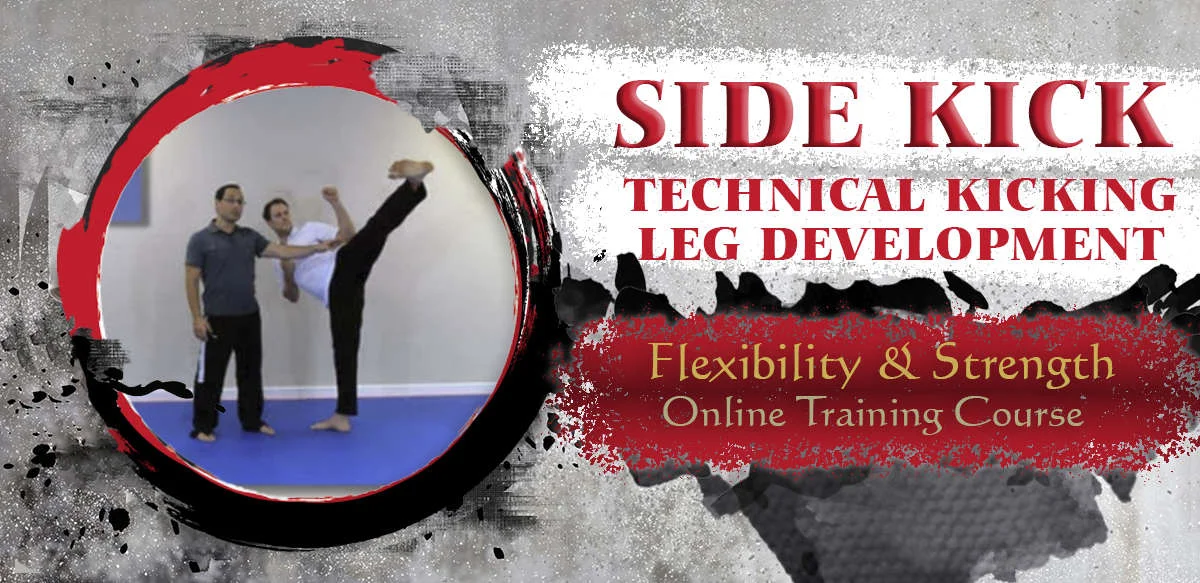
SIDE KICK
Technical Kicking Leg Development
Technical Kicking Leg Development
SIDE KICK: Technical Kicking Leg Development Online Training Program
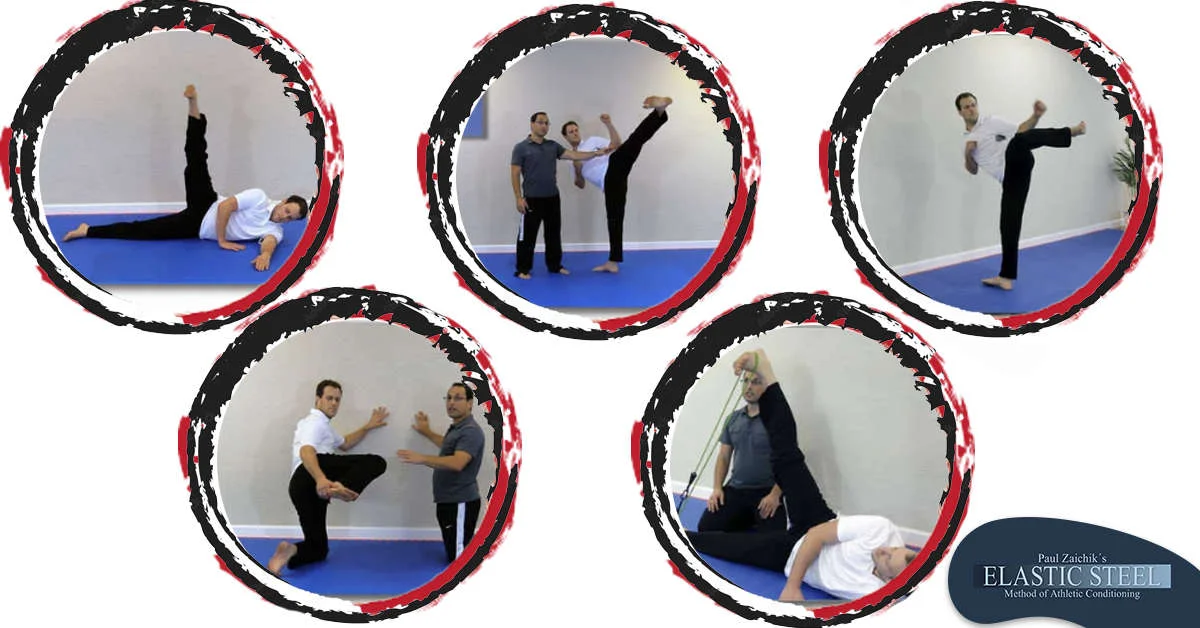
SIDE KICK: Technical Kicking Leg Development Online Training Program
Ideally developing the kicking leg should take place even before a single kick is thrown. However that’s not possible for most people. Everyone who lands on this page, has already thrown kicks.
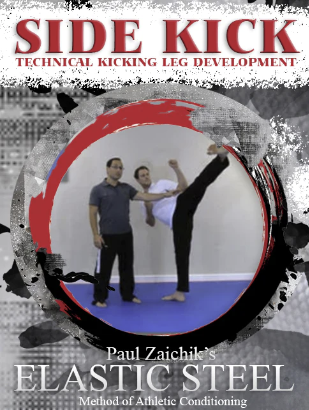
How to understand your kicking leg?
To understand the kicking leg, think of a barbell push jerk. That’s when you hold the barbell on your upper chest, in standing position. You use a short leg push to accelerate the bar up and extend the arms over your head.
The little leg jerk is done because the arms are not strong enough to press the weight with assistance. The arms, in this case, is the kicking leg. Would you try to do a push jerk or even a basic shoulder press, if you can’t lift your arms all the way up to vertical position, because you lack shoulder mobility? Of course you would not.
What if your shoulder was not strong enough to even hold your arms there, would you add additional weight? Of course not. And yet people kick without having proper range of motion or strength.
There is no way a proper technique can ever be developed. Never an optimum power, or speed or accuracy. Why? Because your body is more concerned about you not getting injured, than about “mastering” the skill.
The little leg jerk is done because the arms are not strong enough to press the weight with assistance. The arms, in this case, is the kicking leg. Would you try to do a push jerk or even a basic shoulder press, if you can’t lift your arms all the way up to vertical position, because you lack shoulder mobility? Of course you would not.
What if your shoulder was not strong enough to even hold your arms there, would you add additional weight? Of course not. And yet people kick without having proper range of motion or strength.
There is no way a proper technique can ever be developed. Never an optimum power, or speed or accuracy. Why? Because your body is more concerned about you not getting injured, than about “mastering” the skill.
Requirements for a proper Side Kick
A proper side kick performing leg, requires flexibility in the muscles that prevent abduction (lifting the leg to the side) and prevent medial rotation. (Abduction and medial rotation is what your kicking leg is doing, during side line kicks.) While the medial rotators and adductors need to be strong.
But, not just generally strong. They must be strong in short range. (Short range is where muscle is completely flexed) Also strong hip and knee flexors (to have a good chamber). A beginner who starts kicking, can’t possibly have this.
Unless it’s a new generation of beginners, who now train with various certified instructors in ElasticSteel method.
But, not just generally strong. They must be strong in short range. (Short range is where muscle is completely flexed) Also strong hip and knee flexors (to have a good chamber). A beginner who starts kicking, can’t possibly have this.
Unless it’s a new generation of beginners, who now train with various certified instructors in ElasticSteel method.
In this program you will learn:
- How to strengthen the muscles of the kicking leg in proper ranges for optimal kicks.
- Two forms of Zaichik Stretching Technique (formerly known as Kinesiological Stretching Techniques)
- 4 level short range contractions with 3 exercises per level.
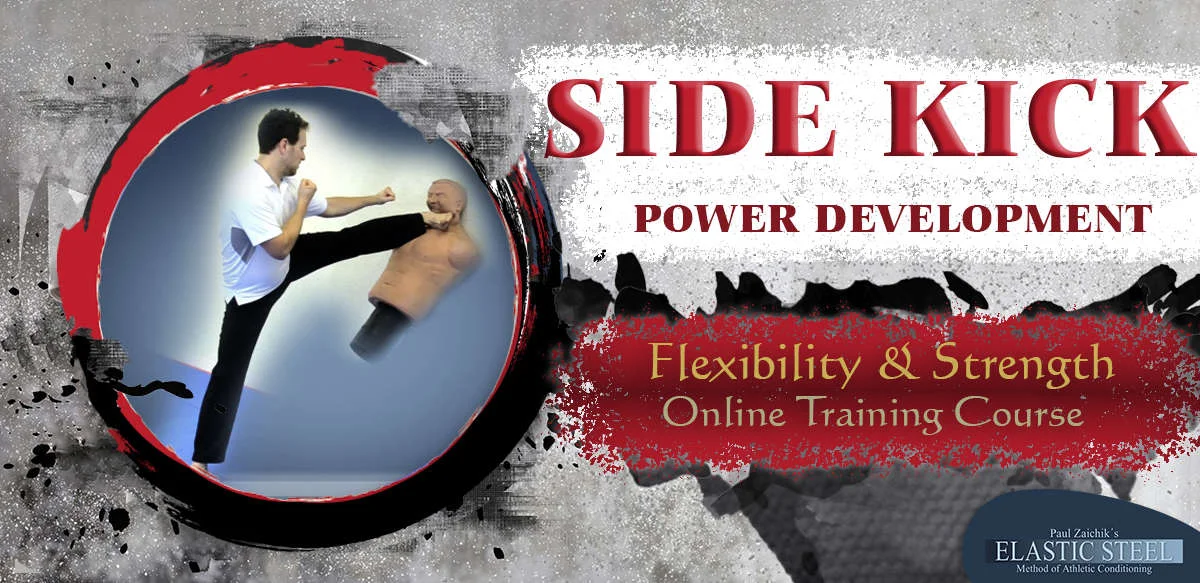
SIDE KICK POWERPOWER DEVELOPMENT
Side Kick Power Online Training Program
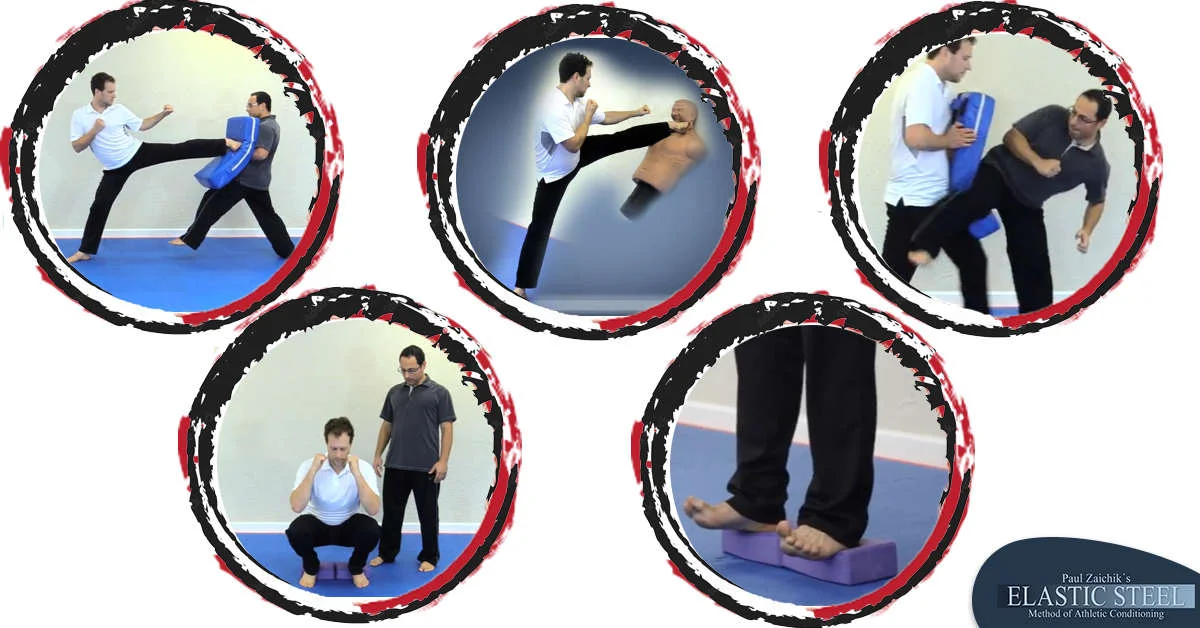
Side Kick Power Online Training ProgramWhat analogy comes to you mind when you visualize a prefect side kick?
- Battering ram?
- A powerful bomb?
- The blow that ends it all?
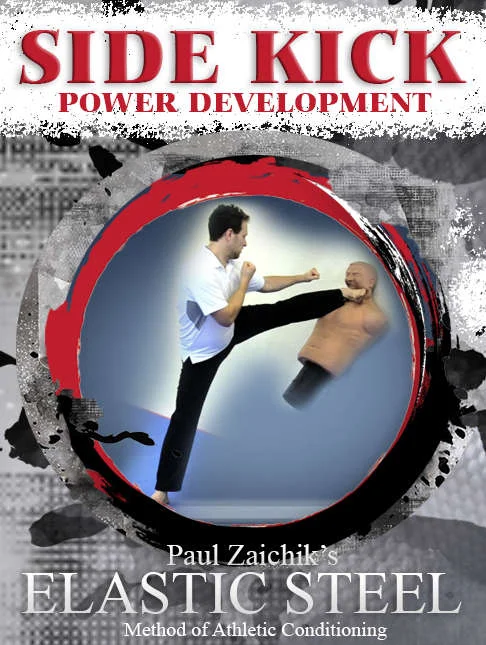
The power of the Side Kick
Side Kick has been developed for power. It’s advantage is full mass acceleration, indirect like with the impact. Joint effort of the strongest muscle groups in the body. No weak link to give or buckle upon impact. All these factors compound a biomechanically advantageous “go to” weapon, when raw power is called for.
With power comes responsibility. I am not talking about “driving the person you kicked to the hospital” type responsibility. But responsibility to your own self. To your own body. The impact of the kick is severe and stress on joints accumulates over time. In order to strive under that stress the body must be properly conditioned to handle that impact.
With power comes responsibility. I am not talking about “driving the person you kicked to the hospital” type responsibility. But responsibility to your own self. To your own body. The impact of the kick is severe and stress on joints accumulates over time. In order to strive under that stress the body must be properly conditioned to handle that impact.
The Path to a powerful kick
Conditioning is the first part of this program. Just a few well selected exercises, will prepare you to kick hard and feel good doing it.
Next comes the acceleration. Force is mass times acceleration. (F=MxA) One of the two variables, (the mass) does not change much. However, we know that two people with the same weight, can kick at very different levels of power. Why is it so? The answer is: acceleration is the key.
The second part of this program focuses on acceleration. Here you learn how to quickly drive the mass into the target.
Finally there is supporting structure work. A kick is not just the kicking leg. The supporting (standing) leg gets the power from the floor. Small increase in functional strength of the non-kicking leg, does wonders for the power of the kick.
In this program you will learn how to develop a powerful side kick. And how to properly train the supporting structures, both for accelerations and stability.
Do you need this program?
Finally there is supporting structure work. A kick is not just the kicking leg. The supporting (standing) leg gets the power from the floor. Small increase in functional strength of the non-kicking leg, does wonders for the power of the kick.
In this program you will learn how to develop a powerful side kick. And how to properly train the supporting structures, both for accelerations and stability.
Do you need this program?
If you have a powerful side kick, you don’t need it. If you side kick is not strong. You need it.
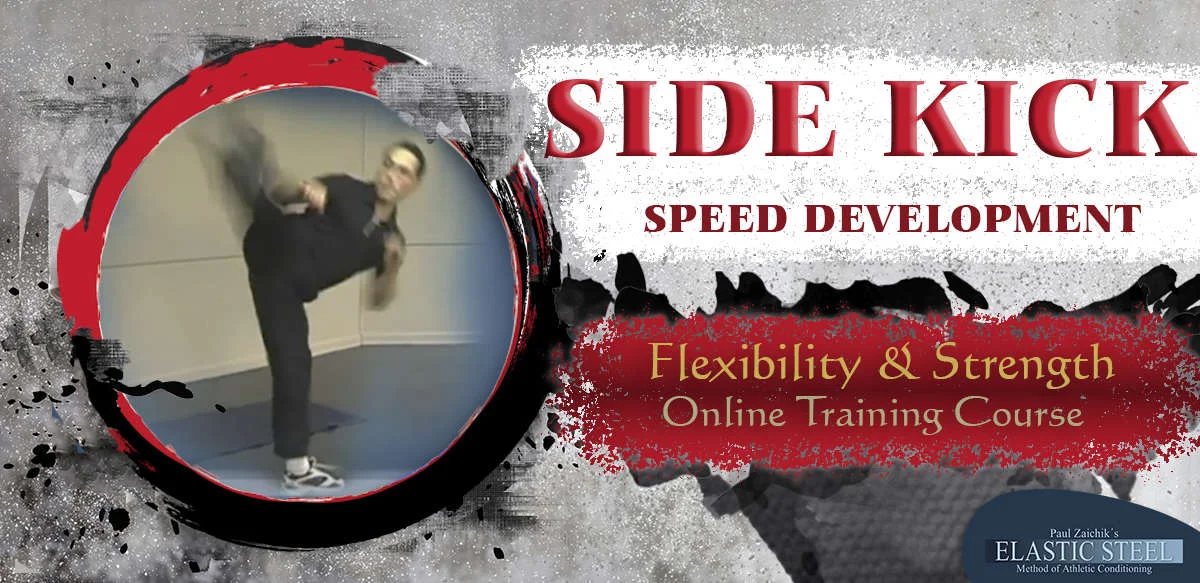
SIDE KICK SPEEDSPEED DEVELOPMENT
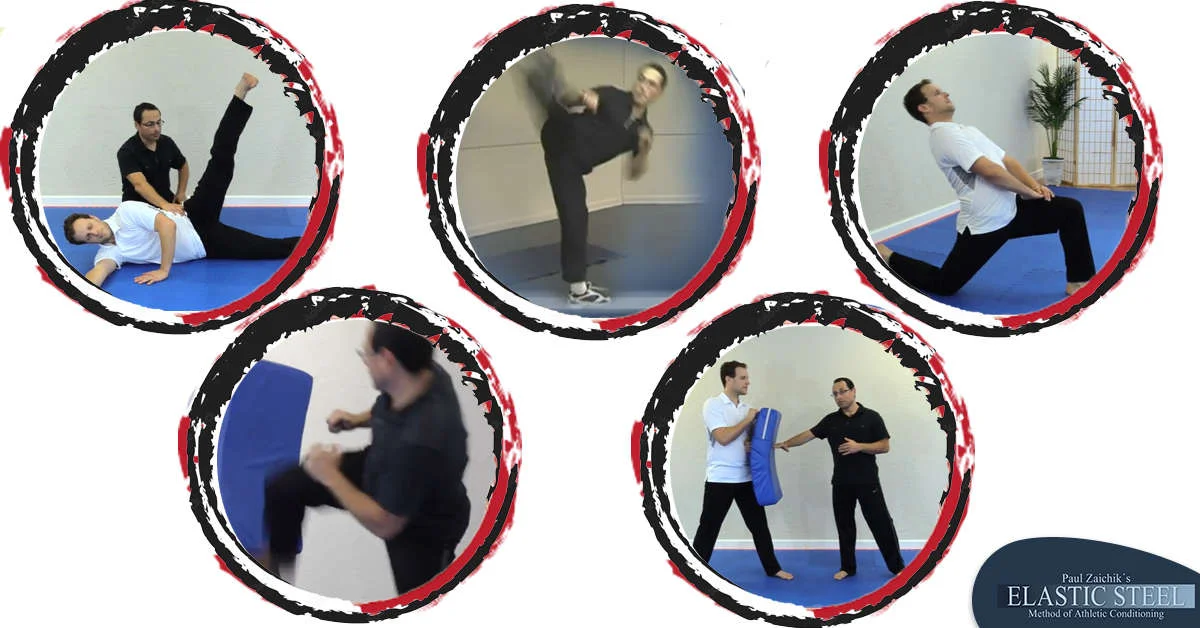
Side Kick Speed Online Training ProgramIn this program you will learn a safe progression for a fast side kick.
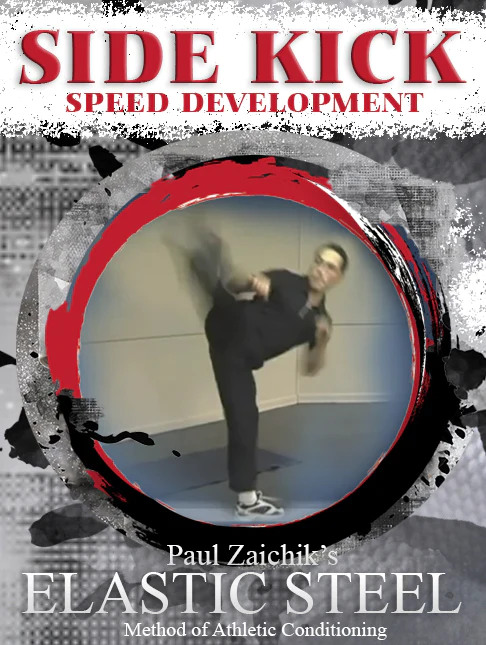
Why “safe progression”? When it comes to speed training chances of injuries is very high.
This does not apply only to side kick of course. Slowing the kick down is the moment when injuries happen. Every fast kick needs to be decelerated. (you are not throwing a rock or a ball, but your foot) So you need to pull the kick back. The faster you kick, the harder you need to pull it back. In case of the side kick the hip flexors and adductors do most of that “pulling back”.
Most people don’t have their decelerator muscles strong enough to contract at high speed. More so in stretched position of those muscles. (Which is where they end up, at the full extension of he kick) And if you sit allot, you are in for even more trouble. (Sitting tightens the hip flexors and adductors)
So here is how it works. Your body likes your muscles healthy ( and not torn.) No Surprise there. If it lets you kick fast, you will tear the muscles. It’s like attaching a rock to a weak string and throwing the rock hard, the string will break. For this reason, your body won’t let you kick fast. There are ways to trick the system of course and do a specific warm up. In that case you will kick faster. ---- ONE TIME! After that you will be very sore at best or injured at worst. Do this few times and chronic injury is guaranteed.
Most people don’t have their decelerator muscles strong enough to contract at high speed. More so in stretched position of those muscles. (Which is where they end up, at the full extension of he kick) And if you sit allot, you are in for even more trouble. (Sitting tightens the hip flexors and adductors)
So here is how it works. Your body likes your muscles healthy ( and not torn.) No Surprise there. If it lets you kick fast, you will tear the muscles. It’s like attaching a rock to a weak string and throwing the rock hard, the string will break. For this reason, your body won’t let you kick fast. There are ways to trick the system of course and do a specific warm up. In that case you will kick faster. ---- ONE TIME! After that you will be very sore at best or injured at worst. Do this few times and chronic injury is guaranteed.
So how is it done properly?
First you need full range of motion in the decelerator muscles. Then you need to strengthen them. Make them stronger first while moving slow and then fast. Finally, you need to work on the kicks assisted by artificial deceleration. Moving from easiest range to the most challenging range. Step by step.
Do you need this program?
Do you need this program?
To answer that question. Ask yourself; Are you throwing your side kick fast? If you are, then you just wasted 5 minutes reading this. (Unless you learned something new) You don’t need this program. If your side kick is not as fast as you want it to be, then you need this program.
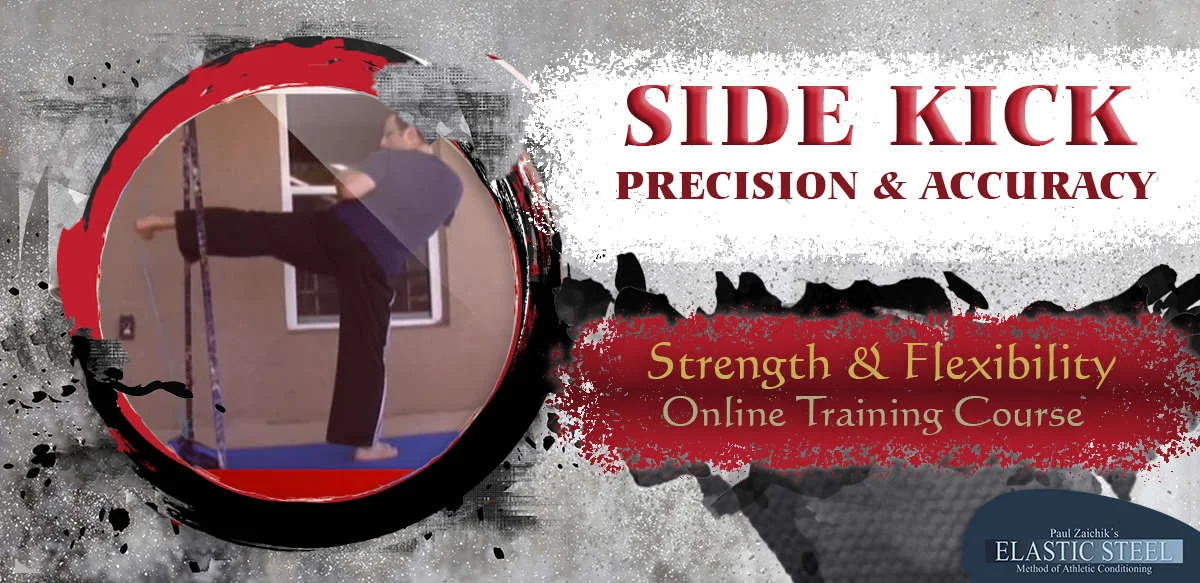
SIDE KICK PRECISION & ACCURACYPRECISION & ACCURACY DEVELOPMENT
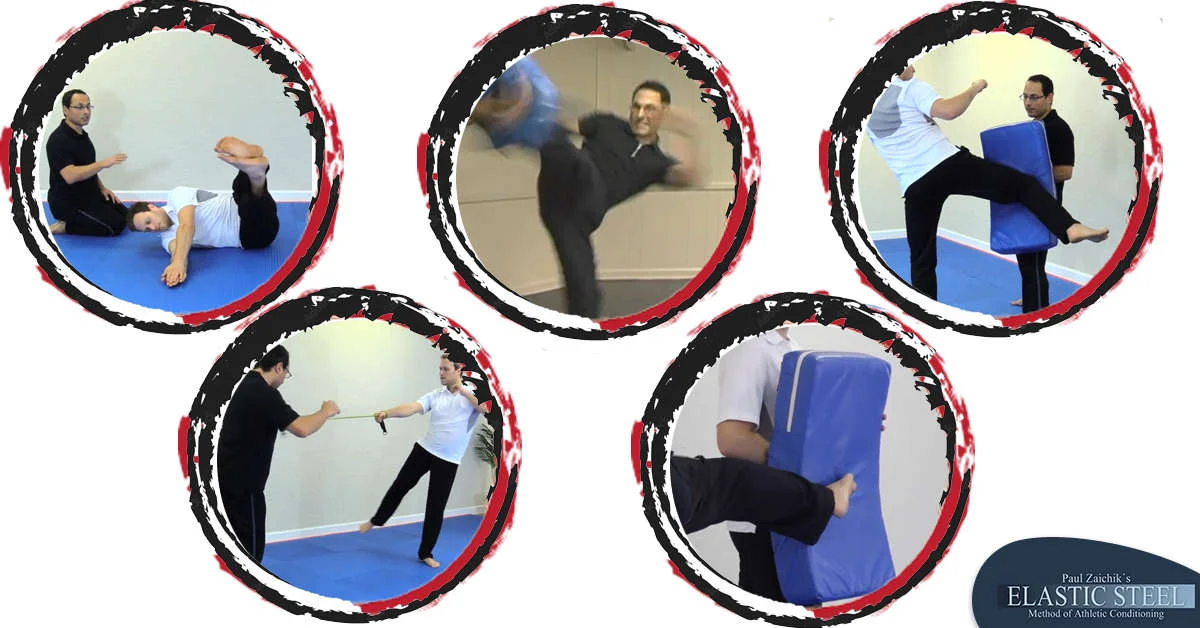
You can try an exercise from this program right now!
SIDE KICK PRECISION & ACCURACY ONLINE TRAINING PROGRAM
In this program you will learn how to land the side kick onto exact intended target, while hitting with full speed and power.
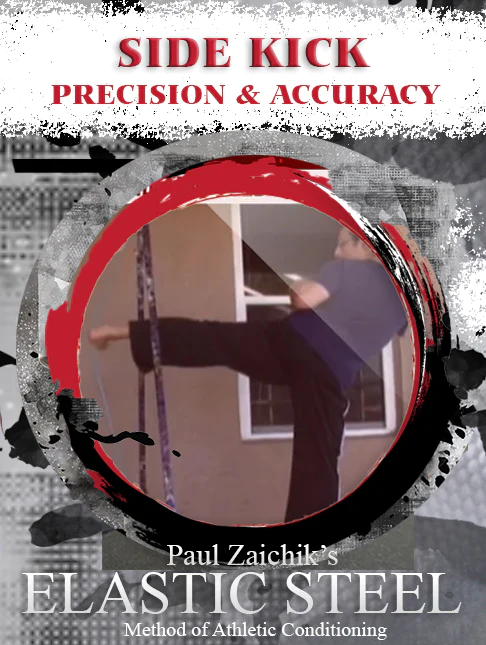
Side kick is the kick known for it’s power.
Side kick is the kick known for it’s power. Side kick is also the least accurate kick of all kicks. Muscles used in the kick are large and powerful. Regulation of these muscles is called gross motor control. The opposite of GMC is fine motor control. The example of FMC is writing with a pen. Fine motor control is what is needed for accuracy. The two types of control rarely naturally co-exist. They are brought together through specialized training.
Being able to place an accurate kick make the difference between “I felt it, it hurts” vs “lights out…” A side kick to the solar plexus missed by an just a little is not as effective. Same for other targets. Knee, jaw, etc. To get full use out of a side kick’s raw power, it must hit the intended target.
The striking surface or point of impact for the side kick is either the heel or the edge of the foot. Heel is more powerful. If you are going to train for accuracy, you might as well go for the all the marbles and focus on maximum returns.
Being able to place an accurate kick make the difference between “I felt it, it hurts” vs “lights out…” A side kick to the solar plexus missed by an just a little is not as effective. Same for other targets. Knee, jaw, etc. To get full use out of a side kick’s raw power, it must hit the intended target.
The striking surface or point of impact for the side kick is either the heel or the edge of the foot. Heel is more powerful. If you are going to train for accuracy, you might as well go for the all the marbles and focus on maximum returns.
The program focuses on the heel. However all the exercises are easily convertible to the edge of the foot, in case you prefer to strike with that point of impact.
How does this program work?
First a heel must be established by the nervous system as the point of impact. This simply means that your body needs to know where you heel is when throwing the side kick. The program starts with this.
Next step is trajectory. In technicality any mastered trajectory can lead to accuracy. It can be a semi-circle of any radius or a straight line. As long as the line of kick is exactly repeated every time, the accuracy will be developed. Having said that, we focus on developing a straight line. (From point A, where heel is at chamber positon to point B, where the target is.)
We focus on mastering a straight line for 3 reasons.
- A straight line is most easily replicated. In other words, if a curved line is called for, the degree of curve is hard to control. This will leads to adjustments at the end of the kick. Those adjustments in turn will decrease the speed and power.
- Shortest distance form A to B is a straight line. In some situations, a millisecond is not significant. In other circumstances, such as competition between two world class athletes, it can make a difference.
- Vector alignment. For maximum generation of power the heel must travel in the same line as the body’s mass is accelerated. When throwing a side kick the mass moves directly at a target. The kick must continue this path. If the kick moves in any other route, the vectors will partially cancel each other. This again will end in loss of power.
Once trajectory is established the kick is practiced with a simple feed back mechanism and is adjusted after each kick. This allows the kicker to get the most out of the kick.
Do you need this program?
Do you need this program?
Place a dot on the target and kick it. Can you hit the dot? Are you slowing the kick down? If you can hit the dot at will, without sacrificing speed and power. Congratulations! You got to send us a video. You definitely don’t need this program.
On the other hand if your kick is not accurate, when thrown at full speed and power. You need the program.
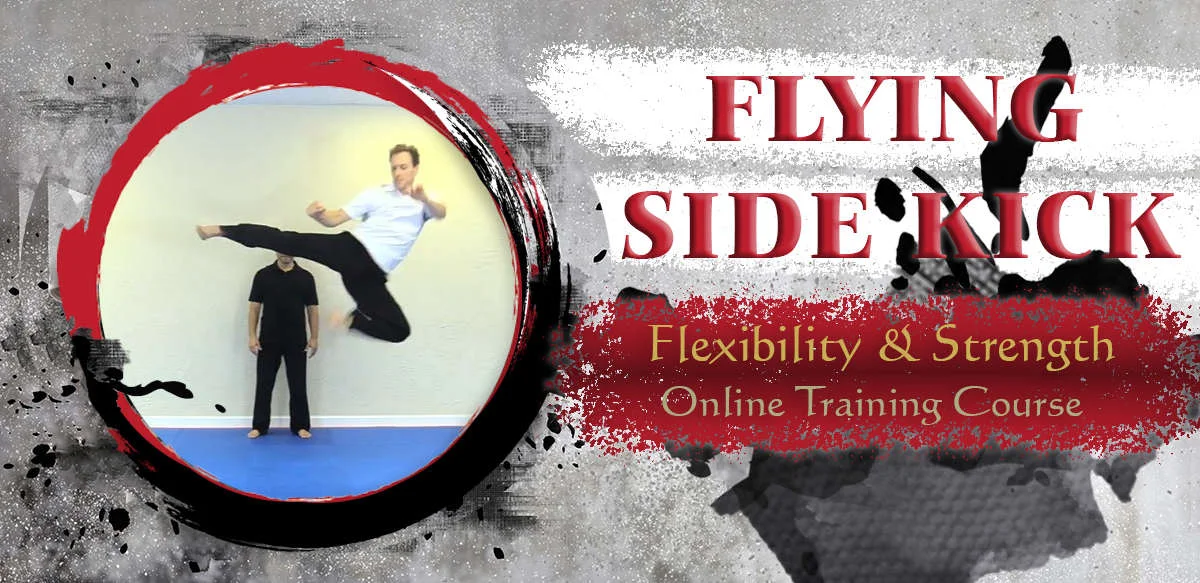
FLYING JUMP SIDE KICK
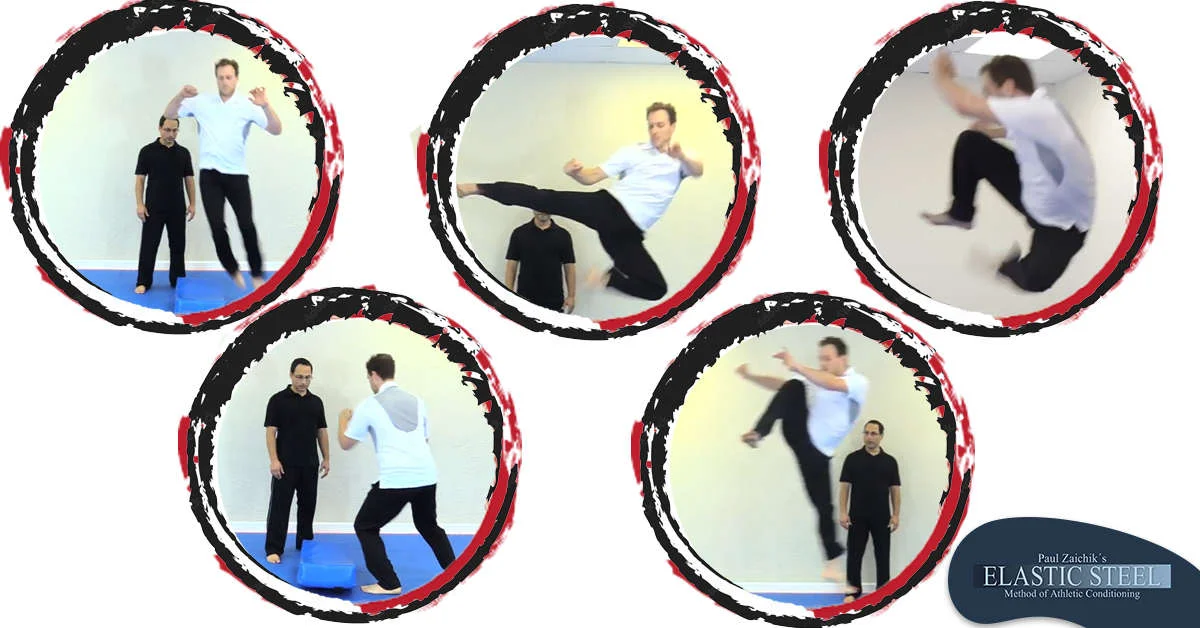
Flying Jump Kick Online Training Program
Ever wonder what muscles are involved in this kick? Take a look:
Flying Jump Kick Online Training Program
Flying Jump Kick is a fancy looking kick, which in most peoples' minds is reserved for the movies, demonstration, and breaking.
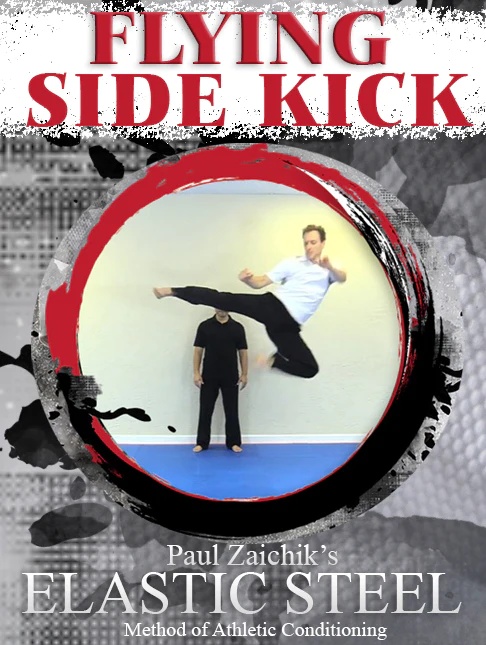
However, from a power point of view, it combines two monsters:
- One is the strongest muscles in the body, the compound leg extensors. Same muscles that help you squat and dead lift heavy weights.
- That not being enough, the Flying Jump Kick also packs the full weight of the body, being accelerated into the target.
The capacity to jump high while performing this kick is found in a proper takeoff. However, to do the kick safely multiple times, the landing is of greatest importance.
Conditioning for the flying jump kick involves strength and plyometric exercises. Ideally, you should land from a height above the one you can reach with the kick. This compensates for other forces. The horizontal vectors and lack of attention paid to the landing in favor of focus on the kick extension.
Our Flying Jump Kick program will show you a safe flying jump kick progression and will help you develop the height of your kick.
Conditioning for the flying jump kick involves strength and plyometric exercises. Ideally, you should land from a height above the one you can reach with the kick. This compensates for other forces. The horizontal vectors and lack of attention paid to the landing in favor of focus on the kick extension.
Our Flying Jump Kick program will show you a safe flying jump kick progression and will help you develop the height of your kick.
In this online training program you will learn:
- A safe flying jump kick progression and develop the height of the kick.
- This is a very straight forward program that will take you only minutes a day to train to get your flying jump kick!
- The capacity to jump high while performing this kick is found in a proper takeoff. However, to do the kick safely multiple times, the landing is of greatest importance.
- Most schools teach the proper mechanics of the kick. A two-step approach, followed by a rear leg side kick and jump. The low jumping height injuries are usually found in lack of pre-conditioning and technical progression.
- Conditioning for the flying jump kick involves strength and plyometric exercises. Ideally, you should land from a height above the one you can reach with the kick. This compensates for other forces. The horizontal vectors and lack of attention paid to the landing in favor of focus on the kick extension.
- The progression in this program involves drills that will teach you how to "fly”, in small increments, gradually. Gradual advancement is what prevents injuries.
Do you need this program?
Think you don’t need this program? Think again! Let’s be honest, who wouldn't love to throw a flying kick like Bruce Lee.
If you're already knocking off your opponents like Bruce Lee then you don’t need this. If not, what are you waiting for?
If you're already knocking off your opponents like Bruce Lee then you don’t need this. If not, what are you waiting for?
Let's recap: In this combo you are getting the following programs:
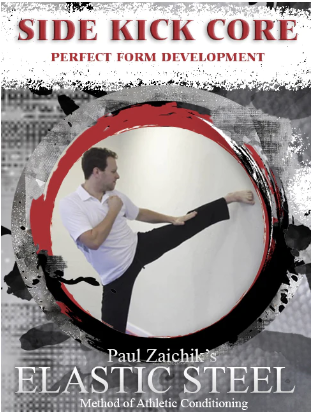






Plus when you sign up for this course you will also get these bonuses:
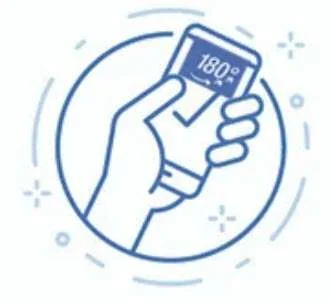
Stretch180 App
Kick Measurement App Online. This app will measure your kicks accurately and tell you how many degrees you are progressing each training session. Track your progress. Keep you engaged and motivated with your training. And keep you focused on your Kicking Goals!

Support Group
Access to a Private Support Group: No longer will you train alone. Now you can be part of a group and train alongside other ElasticSteel practitioners. Once registered for this course you will gain access to a private support group, where you will find 24-hour active community to share your experience with, ask questions and get advice.

Lifetime Access
Once purchased, this course is your to keep forever! There are no hidden fees and no strings attached. You will not be billed monthly, you pay only one time and get unlimited lifetime access to this program which is kept for you in your very own online library for easy access on any device of your choice, anytime, anywhere.
Click on the BUY NOW BUTTON below to get started!
Please note: that these are not downloadable programs, nor are these programs available in DVD format. All our programs are Pre Recorded Online On Demand Video Strength & Flexibility Training Programs. Once you place your order, you will receive an email containing your login information on how to login to your very own online library which will contain all the programs that you purchase from us. This is an online library, which you can access any time that you wish from any device, phone, computer, ipad. There is no time limit for you to view your programs, you get to keep them in your library indefinitely, and access them any time, anywhere, and for as long as you want to!
YOU MAY ALSO BE INTERESTED IN:
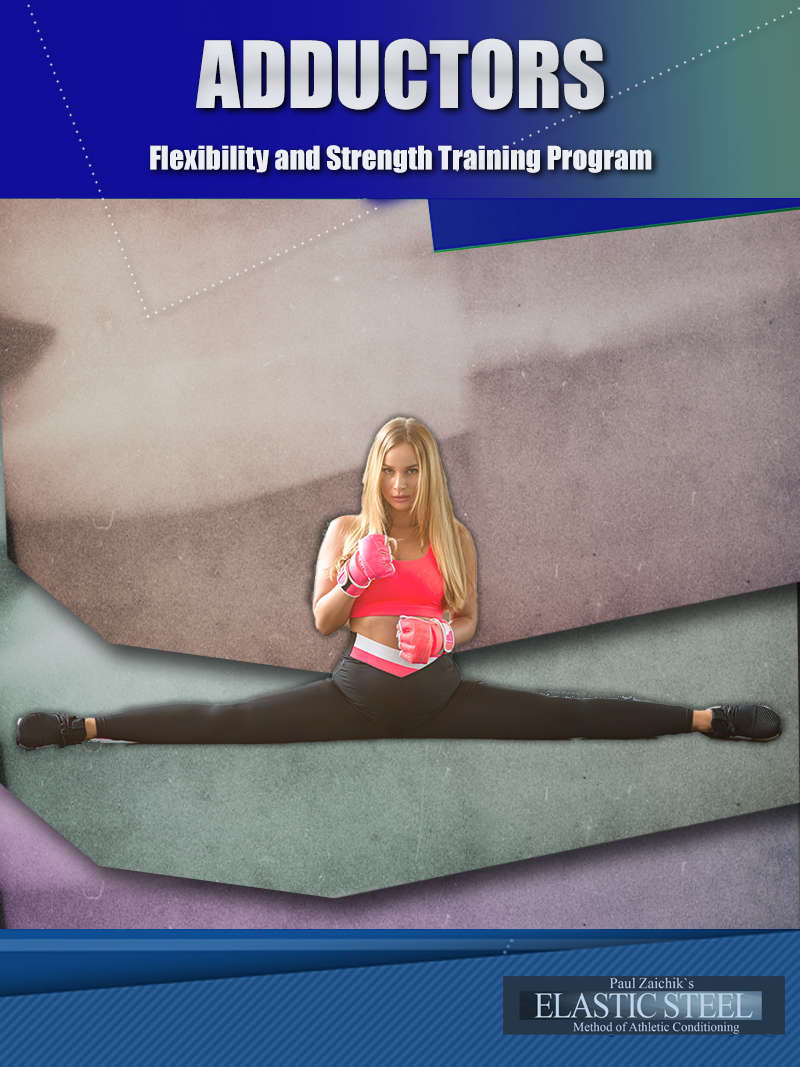
Adductors Strength & Flexibility
This program contains:
Adductors are four muscles whose primary role is hip adduction. Adduction is pulling the limb toward the mid-line of the body.
Additionally some texts list Pectineus as an adductor. There are a number of other muscles that also adduct the leg. Most of those muscles are external rotators of the hip. Since most applications of abduction have a superimposed lateral rotation, additional adductors do not restrict abduction or horizontal abduction. The exception are medial hamstrings, which are internal rotators of the hip.
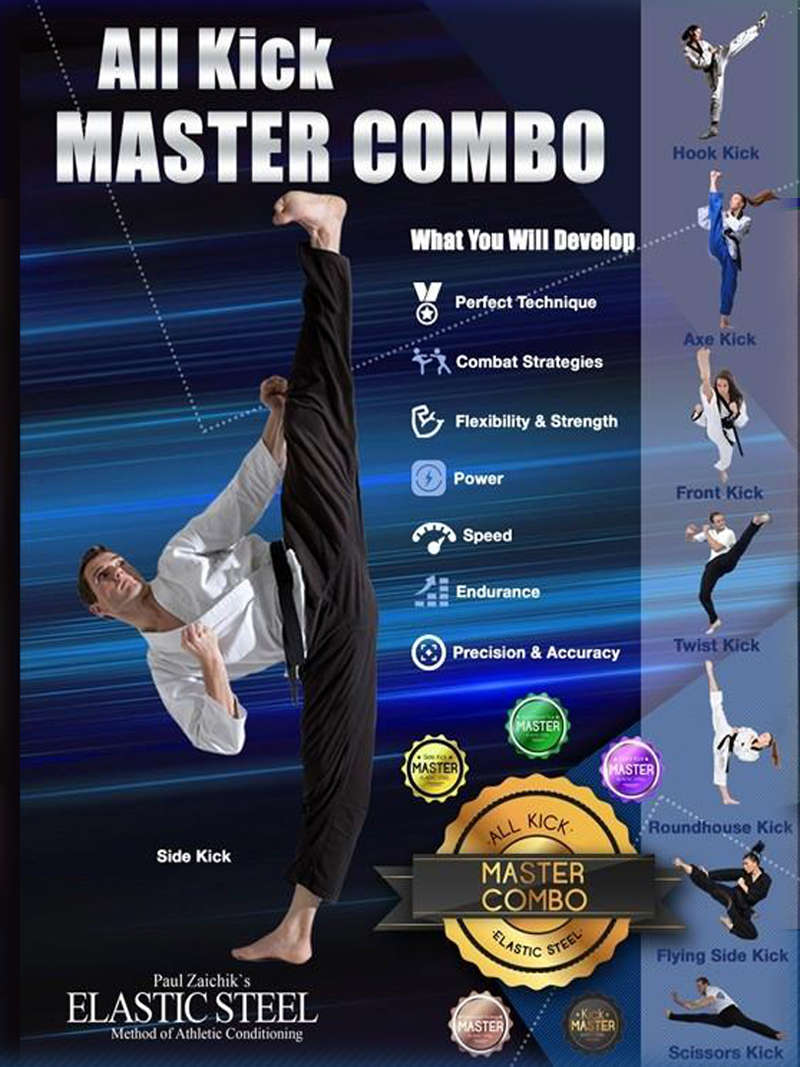
All Kick Master Combo
This Package includes:
Side Kick Training (7 programs)
1- Technical Kicking Leg Development
2- Trunk Flexibility and Strength for Optimum Kicking
3- Supporting Leg Training For Kicking Height
4- Precision and Accuracy
5- Speed Development
6- Power Development
7- Neutralizing Opponents Defense and Guard Penetration Set Ups
Roundhouse and Hook Kicks Training (4 programs)
1- Roundhouse Kick: Technical Kicking Leg Development
2- Roundhouse Kick: Speed Development
3- Roundhouse Kick: Power Development
4- Hook Kick: Power Development
Front Kick Training (5 programs)
1- Front Kick and Front Line Kicks: Technical Kicking Leg Development
2- Front Kick: Speed Development
3- Push Front Kick: Power Development
4- Axe Kick: Power Development
5- Ball of the Foot: Point of Impact
Advance Kick Training (4 programs)
1- Twist Kick Technical Kicking Leg Development
2- Flying Side Kick: Technique and Jumping Height Development
3- Scorpion Kick: Perfect form Development
4- Flying Split Scissors Kick, Two Direction Kick
Kick Retention Training
A specific video focusing on functional kick training.
Three Classic ElasticSteel Functional Strength And Conditioning Books
1- The Gravity Advantage
2- The Gravity Advantage Max
3- The Power of One
Two Extra Programs for Hand Conditioning
1- Fist Point of Impact: Wrist, Knuckles and Forearm Development
2- Palm Strike Strength and Flexibility Training
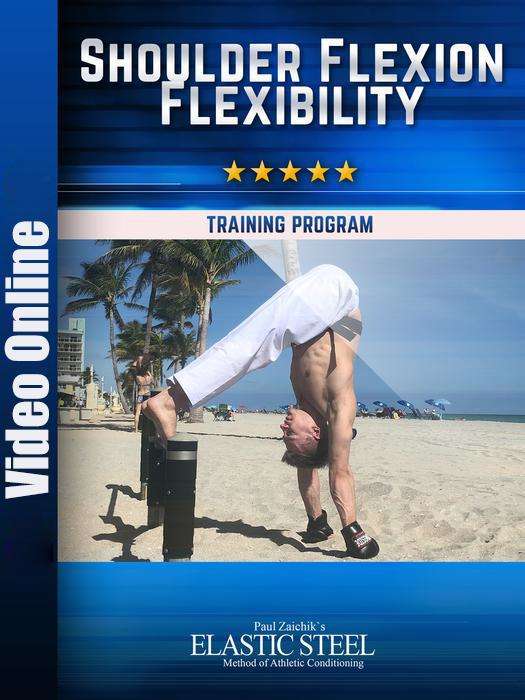
Complete Shoulder Flexion
This program contains:
Being able to stretch the shoulder abductors and extensors, as well as scapula inferior rotators allows the arm to come up to at least vertical line. In many cases more than 180 degree is needed, in throwing sports for example, such as javelin, football and baseball. Same applied to serves in volleyball and rocket sports.
Don’t see what you want? Need help selecting a program? Want to buy more than one program? We can put together a one step checkout for you with all the programs that you wish to buy so you don't need to keep clicking the buy now button over and over again and can checkout one time with all the programs you need.
We’re here for you! Just send us an email to info@easyflexibility.com describing your goals and we will help select the right program for you!
We’re here for you! Just send us an email to info@easyflexibility.com describing your goals and we will help select the right program for you!
Enough time wasted!
Stop wasting time and money, risking your health, hitting plateaus,
wondering how to reach your goal instead of working towards it!
Start your ElasticSteel Side Kick Training Program right NOW and soon
it will be YOU knocking your opponents out with a kick in their head.
wondering how to reach your goal instead of working towards it!
Start your ElasticSteel Side Kick Training Program right NOW and soon
it will be YOU knocking your opponents out with a kick in their head.

